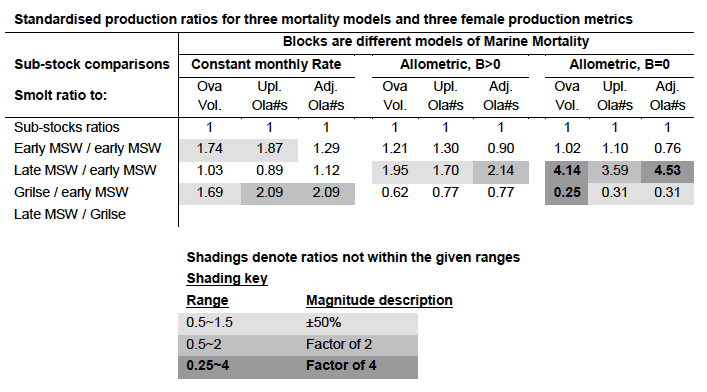Scottish Marine and Freshwater Science Vol 6 No 12: The demography of a phenotypically mixed Atlantic salmon (Salmo salar) population as discerned for an eastern Scottish river
This report investigates the potential for assessment of fish populations at a sub-river
scale. A sophisticated mathematical model was used to separate salmon from a
single river (North Esk, eastern Scotland) into three sub-stocks, based on the
number
Productivity Implications Contrasted Across Marine-mortality Models
If the present sub-stock models represented the real processes well, then their sub-stock productivity ratios (βs from Table 2) should have been close to the same productivity ratios discerned from the typical sizes of females for each sub-stock, but they were not. Table 3 shows that whatever mortality model was used to estimate productivity, the resulting expectation ratio for at least one sub-stock comparison was unbelievably large (for all three alternative productivity metrics). Detailed results for the other two marine-mortality models are illustrated and tabulated in Supplementary Material, parts F and G respectively.
In evolutionary and competitive terms, even just a 10% initial (to smolt-stage) production difference would be a huge (dis-)advantage to a sub-stock (eg Haldane 1924), yet over half (14/27) the tabulated values differed by more than 50%, and that seven differed by factors of between two to four or more (Table 3). Those larger discrepancies frequently involve the late MSW/grilse comparison, which would be unaffected by the ova-size differences between river-zones (Bacon et al. 2012). Even the best fitting of the marine-mortality models (default allometric, DAM) produced unbelievable production ratios (for all three fecundity metrics) for grilse/early MSW. Plausible resolution of this problem might well be found from hypothetical inter-breeding and heritability modules. As an example, the SR curve that would result from the simple amalgamation of late MSW with grilse was calculated (Supplementary Material, part E, Fig.E.1.d).
Table 3. The table gives a comparative productivity index, calculated between different pairs of sub-stocks, such that identical productivity estimates via both estimation routes would always produce an index value of 1.00. The rows show the different pairs of sub-stocks compared. Blocks of three columns show results calculated for three different marine mortality models. Within these triplet-blocks, individual columns show the index as calculated for different productivity metrics (calculated from Bacon et al. 2012 for typically-sized females per sub-stock). Shading and italic/bold font differences (see key) emphasise that none of the marine mortality models produce productivity estimates that are reasonably close to those expected (from female salmon of typical sizes and productivities for the same sub-stocks) across all sub-stock comparisions. Productivity metrics for typically-sized females per sub-stock are: Ova Vol.=total volume of all ova produced per female; Upl.Ova#s=total numbers of ova produced per female in 'upland' river zones (as normally used); Adj.Ova#s= numbers of ova produced per female adjusting for the up-/low-land spawning situations). MSW means Multi-Sea-Winter. See text for further explanation and Supplement part D for details of the calculation of the index values.

Contact
There is a problem
Thanks for your feedback